Lafayette Park and St. Louis's Lafayette Square Neighborhood
Introduction
Text-to-speech Audio
Located in the Lafayette Square neighborhood, Lafayette Park is the oldest developed urban park west of the Mississippi River, being established in 1851 as a 'strolling park' for public recreation and leisure, with wide paths for pedestrians and horse-drawn carriages. For the next three decades, the park offered a place for local residents to enjoy free band concerts, swan boat rides, flower gardens, and a decorative stone grotto. After a major tornado hit in 1896, much of the surrounding neighborhood had to be rebuilt, and some residents left the area and moved west. Lafayette Park further declined after 1904, when the World's Fair was held in nearby Forest Park, diverting city resources and the city's focus towards that much larger urban park. In the 1960s, preservationists began to restore the elegant Victorian and Second Empire townhouses in Lafayette Square, returning the architecture to its original character. Due to the successful efforts of the Lafayette Square Restoration Committee, which led to the inclusion of the Lafayette Square Historic District on the National Register of Historic Places, the area experienced a resurgence. Today, Lafayette Square is a popular site for coffee shops, restaurants, and gift shops, while Lafayette Park features concerts, outdoor film screenings, and baseball games.
Images
Lafayette Square street sign
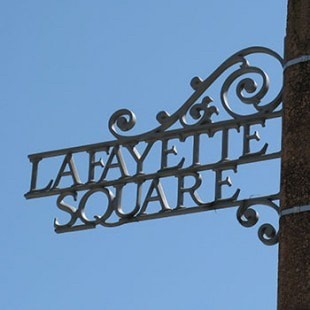
Postcard of Lafayette Park, c. 1903
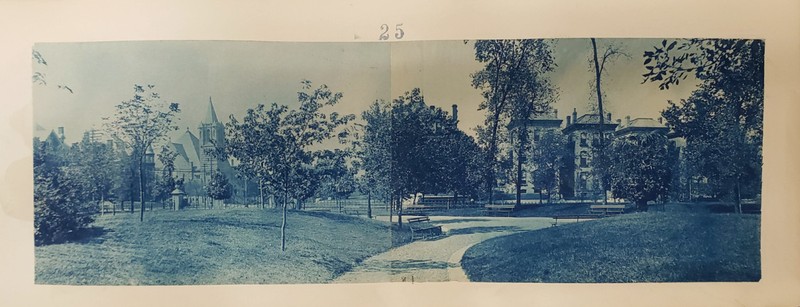
Townhouses in Lafayette Square
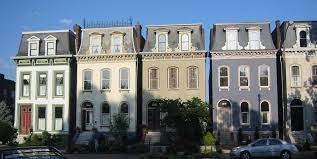
Townhouses in Lafayette Square
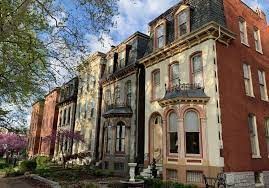
Townhouses in Lafayette Square
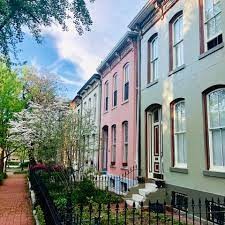
Lafayette Park gazebo
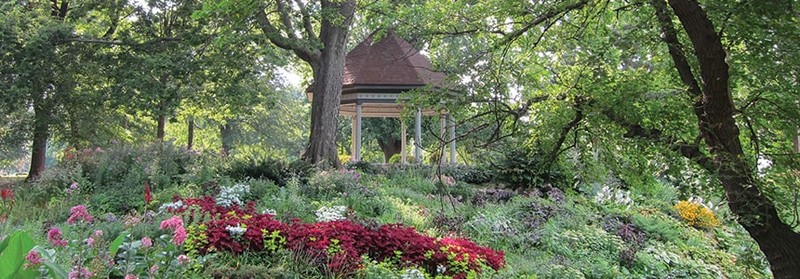
Lafayette Park bridge
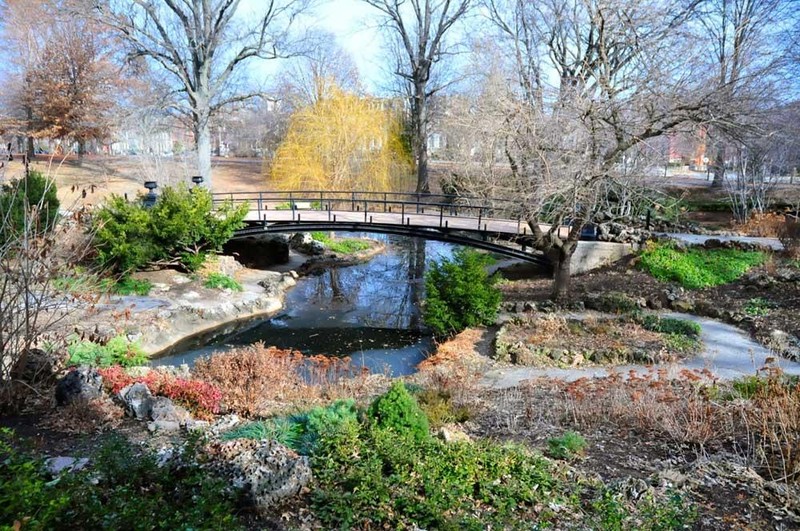
Park superintendent's house in Lafayette Park
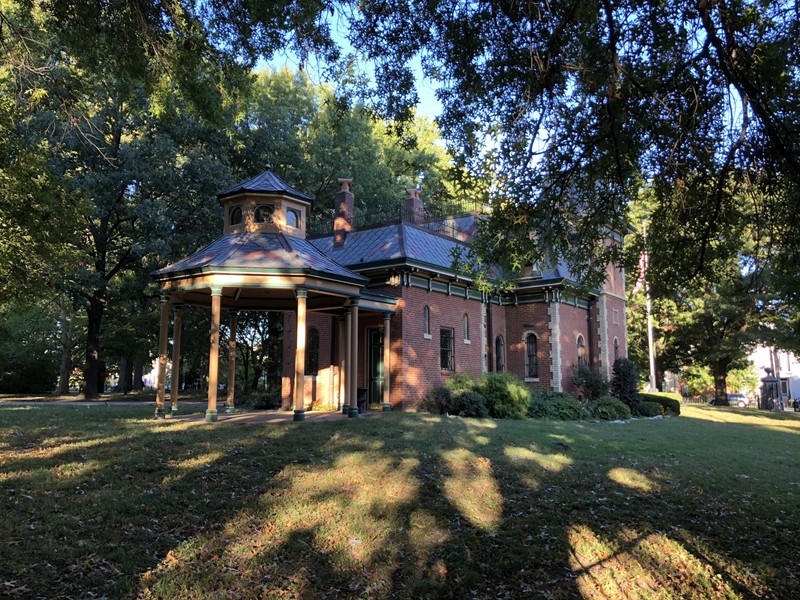
The boathouse at Lafayette Park
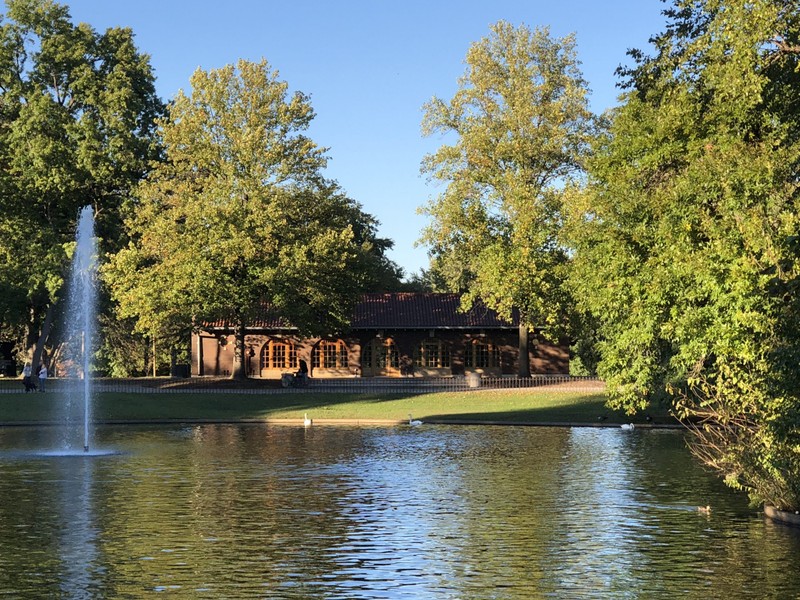
Backstory and Context
Text-to-speech Audio
Lafayette Park is located at the center of Lafayette Square, a residential neighborhood of stately homes built in the Victorian and Second Empire styles, which showcase the area's architectural character. In an essay titled, A Walk Around The Square, Thomas Keay described this setting as a "reminder of Victorian St. Louis in its most flamboyant years, the last quarter of the nineteenth century." Although French colonization of the area had occurred much earlier, in 1764, displacing the Osage and other indigenous tribes, an increase in settlement during the early nineteenth century led to the establishment of St. Louis Commons (a European-style common field system) on land that eventually became Lafayette Park. Under this arrangement, the land was held in common by European settlers for agricultural use and as pasture for farm animals. To this day, Lafayette Park remains the only land in the city which has never been privately owned.
In 1851, Lafayette Park was officially established via a city ordinance and dedicated as the city's first public park. Considered the first developed urban park west of the Mississippi River, it was named for the Marquis de Lafayette, a hero of the American Revolution who had visited St. Louis in 1825. The idea for Lafayette Park was proposed by Colonel Thorton Grimsley, who wanted to set aside part of the St. Louis Commons for public use as a park. However, many people refused to see the value of preserving this area from future development, as it was considered "too remote" from the city. At that time, the City of St. Louis extended west from downtown no further than Fourteenth Street. Nevertheless, the park was established, and in 1858, its athletic field was used as a training site for local militias, who referred to it as the 'parade grounds,' while marching past the park's statue of George Washington. During the early 1860s, Lafayette Park also served a campground for Union troops amidst the Civil War.
When the war ended, the site was used exclusively as a public park for recreation and leisure. The landscape featured a lake and bridge, flower gardens, a music bandstand, and wide paths suitable for walking and carriage drives. As the population of St. Louis expanded, Lafayette Square became one of the city's most desirable neighborhoods. The 30-acre park drew visitors, and a number of prominent residents built homes around it. These included two well-known steamboat pilots named Horace Bixby and Joseph LaBarge; several different St. Louis mayors; Louis Brandeis, who later became a U.S. Supreme Court Justice; and Montgomery Blair, appointed Postmaster General by President Abraham Lincoln. Blair had served as co-counsel for Dred Scott in the landmark U.S. Supreme Court case, Dred Scott v. Sanford. His former home is now an official guesthouse for the President of the United States. Other residents in Lafayette Square included those had amassed fortunes in burgeoning enterprises, such as the wine, jewelry, and mining industries.
When a major tornado hit in 1896, the cyclone devastated the park and the surrounding neighborhood. Some residents rebuilt their homes, but many decided to leave the area entirely. Lafayette Square further declined throughout the early decades of the twentieth century, as the city's focus shifted towards the much larger Forest Park, the site of the 1904 World's Fair. It was not until the 1960s that group of preservationists began to restore the historic homes in Lafayette Square. Due to the efforts of the Lafayette Square Restoration Committee, the area experienced a resurgence of interest in the latter half of the twentieth century, and in 1972, the Lafayette Square Historic District was added to the National Register of Historic Places.
Today, the neighborhood is dotted with restaurants, coffee shops, yoga studios, gift shops, and other small businesses, along with many well-preserved homes throughout Lafayette Square, some of which have been converted into bed-and-breakfast hotels. Meanwhile, a 2004 Master Plan for Lafayette Park saw the restoration of the landscape and its historic structures. The park is currently a popular site for summer movie screenings, baseball games, and other forms of outdoor recreation. Travel writers and local bloggers often describe the feeling of walking around Lafayette Square and Lafayette Park as stepping back in time. As noted by Explore St. Louis:
"Like a picture out of a Victorian novel, the park’s flowers, natural grasses, towering trees, waterfalls, fountains and iconic iron bridges provide a peaceful backdrop and respite. The original iron and stone fence erected in 1869 still encircles the park’s perimeter. Its history and beauty define its charm. Along the self-guided historical walking tour, visitors will pass the athletic field, which served as a military parade ground in 1858; a bronze statue of George Washington created in 1869 by French Sculptor Jean-Antoine Houdon; a circular horse watering trough-turned planter; and a music pavilion with the original base from 1896, among numerous other notable landmarks. In days of yore, Victorians rowed around the park’s main lake in swan boats. Today, the swan house and fountain are reproductions of the Victorian originals."
Cite This Entry
Hughes, Jenevieve and Clio Admin. "Lafayette Park and St. Louis's Lafayette Square Neighborhood." Clio: Your Guide to History. January 22, 2023. Accessed March 31, 2025. https://theclio.com/entry/163193
Sources
Lafayette Square, Lafayette Square. Accessed January 18th, 2023. https://lafayettesquare.org/.
1903: The Lafayette Park Photo Collection, Lafayette Square. Accessed January 18th, 2023. https://lafayettesquare.org/1903-the-lafayette-park-photo-collection/.
About, Lafayette Square. Accessed January 19th, 2023. https://lafayettesquare.org/about/.
Historical Archives, Lafayette Square. Accessed January 19th, 2023. https://lafayettesquare.org/archives/.
Keay, Thomas. Excerpts from "A Walk Around The Square" by Thomas Keay, Lafayette Square. Accessed January 19th, 2023. https://lafayettesquare.org/about/.
Lafayette Park, Lafayette Square. Accessed January 19th, 2023. https://lafayettesquare.org/visit/lafayette-park/.
Voight, Jason. Lafayette Park and Square: Missouri's Civil War, Hmdb. June 12th, 2022. Accessed January 21st, 2023. https://www.hmdb.org/m.asp?m=140052
Lafayette Square Historic District: Nomination Form - National Register of Historic Places, National Archives. Accessed January 21st, 2023. https://catalog.archives.gov/id/63820901.
Lafayette Square, Explore St. Louis. Accessed January 21st, 2023. https://explorestlouis.com/things-to-do/neighborhoods/lafayette-square/.
Lafayette Square
Lafayette Park archives
WikiCommons
Lafayette Square
Lafayette Square
City of St. Louis
City of St. Louis
Lafayette Square
Lafayette Square

